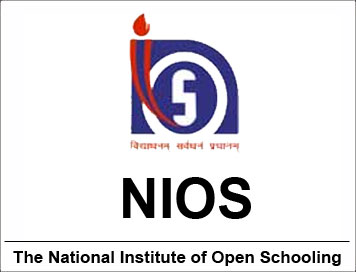(Download) NIOS Practical Papers Of Biology Senior Secondary
Disclaimer: This website is NOT associated with CBSE, for official website of CBSE visit - www.cbse.gov.in
(Download) NIOS Practical Papers Of Biology Senior Secondary
Scheme of Biology Practical Examination
Duration: 3 hours
Maximum Marks: 20
Sample Question Paper
1. To perform an experiment (Any one out of the following A and B) 4
A. To dissect and display the general viscera of Rat and to flag-label Six
specified organs.
OR
B. To demonstrate or carry out exercises (Any two out of the following)
(i) Osmosis in potato/carrot.
(ii) Plasmolysis in Rhoeo Tradescantia leaf.
(iii) Rate of Photosynthesis in Hydrilla (or any other aquatic plant)
(iv) Action of Salivary amylase on starch.
(v) Chemical rest of abnormal constituents in urine (sugar and albumin)
(vi) Identification of given flower, write its flower formula and draw its
floral diagram.
2. To identify and comment upon four speciments/slide A-D. 3
3. To prepare a temporary stained mount of the material provided and to identify and make a labeled sketch. 3
4. To submit a project report (Prepared during the academic session) 2
5. Practical Record book 3
6. Viva-voce 5
List Of Experiments In Biology
1. (A) Dissection of rat and flag-labelling its various organs
(a) flag- labeling of six specified parts Stomach, appendix, liver, pancreas,
spleen, diaphragm, heart, dorsal aorta, kidney, adrenal, testis, ovary.
(b) Pinning, stretching, display. 6* ½=3
(B) Demonstration and carrying out of any two exercises 1 4
i) Osmosis in potato/carrot
ii) Plasmolyses in Rhoeo/Tradescantia leaf
iii) Rate of photosynthesis in Hydrilla or any other aquatic plant
iv) Action of salivary amylase on starch
v) Chemical tests of abnormal constituents in urine (sugar and albumin)
vi) Identification of given flower, write its flower formula and draw its floral
diagram.
(For exercise i-v)
- Setting up of the experiments and demonstration 1
- Recording the observations and conclusions. 1
(For exercise vi)
- Writing the flower formula 1
- Drawing the floral diagram = 1
2 marks for each exercise
(2+2) =4
2. To identify and comment upon the four speciments/slides A-D
A. Any one prepared slide showing microscope structures of the following
i) Dicot root
ii) Dicot leaf
iii) Dicot stem
iv) Monocot root
v). Monocot leaf
vi).Monocot stem
v) cartilage
vi) Bone
vii) Blood
viii) Liver
ix) Kidney
x) Testis
xi) Ovary
xii) Skin
B. Any one of the following speciments :
i) Chlamydomonas (vegetative)
ii) Spirogyra-( vegetative or conjugation stage)
iii) Any one stage of Mucor/Rhizopus
iv) Moss gametophyte or sporophyte
v) Fern (sporophyte/prothelus/Sporangium)
vi) Pinus (male cone/female cone/long and dwarf shoot)
C. Identification and classification up to class and listing main features of any one of the following speciments:
i) paramecium
ii) Sponge
iii) Hydra
iv) Tapeworm
v) Liver-fluke
vi) Leech
vii) Butterfly/moth
viii) Scorpion
ix) Pila
x) Starfish
xi) Dogfish
xii) Rohu
xiii) Toad
xiv) Wall lizard
xv) Any snake
xvi) Bat
D. Identification and comment an any of the following:
i) Life history stages of silk moth
ii) Early cleavage in frog egg
iii) Frog blastula (whole mount/T.S.)
iv) Gastrula of frog (whole mount/T.S.)
v) Neurula of frog (whole mount/T.S.)
vi) Tadpole of frog (whole mount/T.S.)
Identification ¼
Comments ¼
Labeled diagram/Classification = ¼
4 items*3/4 = 3 marks
3. Prepration of a temporary stained mount of the material provided, and to make labeled sketch.
(Any one of the following)
i) Epidermal peel of onion
ii) Sqamous epithelium of frog
iii) Squash preparation of root tip of onion to show any one stage of mitosis
iv) Striated muscles of cockroach
v) T.S. of cucurbita stem to show xylem and phloem
vi) T.S. petiole of datura or any other plant showing any one tissue
(parenchyma/collenchyma/Schlerenchyma)
Slide preparation = 2
3
Labeled sketch = 1
4. Submission of a project report on any one topic of interest.
(A few topics are suggested below as samples)
i) Enrichment information on any text related item. (clipping/s from
newspapers or journals etc.)
ii) Collection, preservation and presentation of flora (herbarium)/fauna.
iii) Preparation of a bird diary-listing birds observed during different seasons
in the neighbourhood and recording their feeding and other habits including
nesting etc.
iv) Hereditary observation-making family pedigrees showing occurrence of
(i) tongue rolling
(ii) PTC tasting
(iii) thumb bending etc.
(v) Visit to a zoo/aquarium, natural history museum/wild life sanctuary etc.2
Click Here To Download Practical Paper
<< Go Back To Main Page
